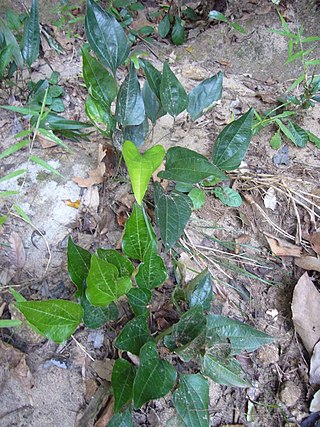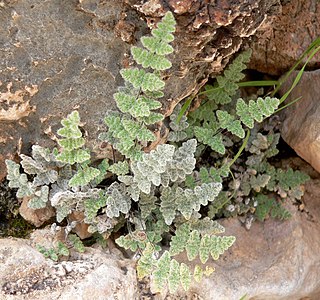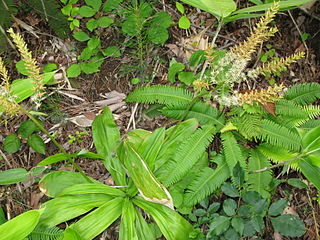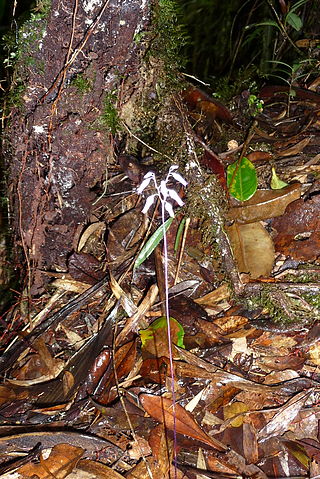
The Dioscoreales are an order of monocotyledonous flowering plants, organized under modern classification systems, such as the Angiosperm Phylogeny Group or the Angiosperm Phylogeny Web. Among monocot plants, Dioscoreales are grouped with the lilioid monocots, wherein they are a sister group to the Pandanales. In total, the order Dioscoreales comprises three families, 22 genera and about 850 species.

Dioscoreaceae is a family of monocotyledonous flowering plants, with about 715 known species in nine genera. The best-known member of the family is the yam.

The genus Tacca, which includes the batflowers and arrowroot, consists of flowering plants in the order Dioscoreales, native to tropical regions of South America, Africa, Australia, Southeast Asia, and various Oceanic islands. In older texts, the genus was treated in its own family Taccaceae, but the 2003 APG II system incorporates it into the family Dioscoreaceae. The APG III and APG IV systems continue to include Tacca in Dioscoreaceae.

Dioscorea oppositifolia is a type of yam (Dioscorea) native to Myanmar (Burma) and to the Indian Subcontinent.

Afrothismia is a genus of plant in family Burmanniaceae, first described as a genus in 1906. It is native to tropical Africa.

Oxygyne is a genus of plant in family Burmanniaceae, first described as a genus in 1906. It has a highly disjunct distribution, found in Japan in East Asia and in Cameroon in Central Africa.

Trichopus is a genus of two known species of flowering plants. These plants were formerly included in the family Trichopodaceae, but are now considered to belong to Dioscoreaceae.

Dioscorea pentaphylla is a species of flowering plant in the yam family known by the common name fiveleaf yam. It is native to southern and eastern Asia as well as New Guinea and northern Australia. It is widely cultivated as a food crop and naturalized in Cuba and on several island chains in the Pacific.

Cheilanthoideae is one of the five subfamilies of the fern family Pteridaceae. The subfamily is thought to be monophyletic, but some of the genera into which it has been divided are not, and the taxonomic status of many of its genera and species remains uncertain, with radically different approaches in use as of December 2019.

Burmannia is a genus of flowering plants long thought of as related to orchids, although more recent studies suggest closer affinities with either the Dioscoreales or the Melanthiales. The plants are herbs, partially autotrophic (photosynthetic) but also partially parasitic on soil fungi.

Metanarthecium is a genus of monocotyledonous flowering plants native to eastern Asia. Its only known species is Metanarthecium luteoviride, known from Japan, Korea, and the Kuril Islands.
Nietneria is a genus of plants in the Nartheciaceae. It has two known species, both native to northern South America.
Haplothismia is a genus of myco-heterotrophic plants in family Burmanniaceae, first described as a genus in 1952. There is only one known species, Haplothismia exannulata, endemic to southern India. The plant is mycotrophic, i.e. lacking chlorophyll and obtaining sustenance from fungi in the soil.
Miersiella is a monotypic genus of flowering plants in the Burmanniaceae, first described as a genus in 1903. It contains only one known species, Miersiella umbellataUrb. It is native to South America.
Marthella is a genus of flowering plants in the Burmanniaceae, first described as a genus in 1903. It contains only one known species, Marthella trinitatis, endemic to the Island of Trinidad. It is considered critically endangered and only naturally appears in Northern Range Forest Reserve Section B. As a conservation measure, it is being cared for in the Heights of Aripo Village as a form of ex situ conservation.
Hexapterella is a genus of flowering plants in the Burmanniaceae, first described as a genus in 1903. It is native to northern South America and to the Island of Trinidad.

Dictyostega is a genus of flowering plants in the Burmanniaceae, first described as a genus in 1840. It contains only one known species, Dictyostega orobanchoides, native to southern Mexico, Central America, Trinidad, and South America ).
Cymbocarpa is a genus of flowering plants in the Burmanniaceae, first described as a genus in 1840. It is native to Central America, northern South America and the West Indies

Apteria is a genus of flowering plants in the Burmanniaceae, first described as a genus in 1834. It contains only one known species, Apteria aphylla, the nodding-nixie, native to the southern United States, Mexico, Central America, the West Indies, and South America.

The APG IV system of flowering plant classification is the fourth version of a modern, mostly molecular-based, system of plant taxonomy for flowering plants (angiosperms) being developed by the Angiosperm Phylogeny Group (APG). It was published in 2016, seven years after its predecessor the APG III system was published in 2009, and 18 years after the first APG system was published in 1998. In 2009, a linear arrangement of the system was published separately; the APG IV paper includes such an arrangement, cross-referenced to the 2009 one.













